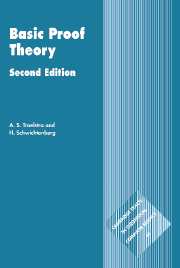Book contents
- Frontmatter
- Contents
- Preface
- 1 Introduction
- 2 N-systems and H-systems
- 3 Gentzen systems
- 4 Cut elimination with applications
- 5 Bounds and permutations
- 6 Normalization for natural deduction
- 7 Resolution
- 8 Categorical logic
- 9 Modal and linear logic
- 10 Proof theory of arithmetic
- 11 Second-order logic
- Solutions to selected exercises
- Bibliography
- Symbols and notations
- Index
9 - Modal and linear logic
Published online by Cambridge University Press: 05 June 2012
- Frontmatter
- Contents
- Preface
- 1 Introduction
- 2 N-systems and H-systems
- 3 Gentzen systems
- 4 Cut elimination with applications
- 5 Bounds and permutations
- 6 Normalization for natural deduction
- 7 Resolution
- 8 Categorical logic
- 9 Modal and linear logic
- 10 Proof theory of arithmetic
- 11 Second-order logic
- Solutions to selected exercises
- Bibliography
- Symbols and notations
- Index
Summary
Another possible title for this chapter might have been “some non-standard logics”, since its principal aim is to illustrate how the methods we introduced for the standard logics M, I and C are applicable in different settings as well.
For the illustrations we have chosen two logics which are of considerable interest in their own right: the wellknown modal logic S4, and linear logic. For a long time modal logic used to be a fairly remote corner of logic. In recent times the interest in modal and tense logics has increased considerably, because of their usefulness in artificial intelligence and computer science. For example, modal logics have been used (1) in modelling epistemic notions such as belief and knowledge, (2) in the modelling of the behaviour of programs, (3) in the theory of non-monotonic reasoning.
The language of modal logics is an extension of the language of first-order predicate logic by one or more propositional operators, modal operators or modalities. Nowadays modal logics are extremely diverse: several primitive modalities, binary and ternary operators, intuitionistic logic as basis, etc. We have chosen S4 as our example, since it has a fairly well-investigated proof theory and provides us with the classic example of a modal embedding result: intuitionistic logic can be faithfully embedded into S4 via a so-called modal translation, a result presented in section 9.2.
Linear logic is one of the most interesting examples of what are often called “substructural logics” – logics which in their Gentzen systems do not have all the structural rules of Weakening, Exchange and Contraction.
- Type
- Chapter
- Information
- Basic Proof Theory , pp. 283 - 316Publisher: Cambridge University PressPrint publication year: 2000



